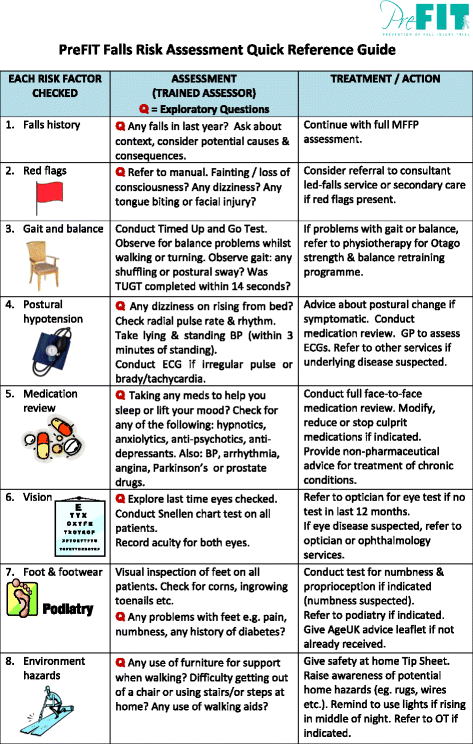10 Easy Facts About Dementia Fall Risk Explained
10 Easy Facts About Dementia Fall Risk Explained
Blog Article
Rumored Buzz on Dementia Fall Risk
Table of ContentsThe smart Trick of Dementia Fall Risk That Nobody is DiscussingDementia Fall Risk Things To Know Before You Get ThisIndicators on Dementia Fall Risk You Should KnowRumored Buzz on Dementia Fall RiskSome Ideas on Dementia Fall Risk You Should Know
The FRAT has 3 areas: fall threat status, threat factor list, and action plan. A Loss Danger Standing includes data concerning background of recent falls, drugs, psychological and cognitive condition of the person - Dementia Fall Risk.If the client scores on a risk aspect, the corresponding variety of factors are counted to the patient's autumn danger rating in the box to the much best. If a person's loss risk score completes 5 or higher, the person goes to high threat for drops. If the patient scores just 4 factors or lower, they are still at some danger of dropping, and the nurse ought to use their best professional assessment to take care of all fall risk factors as part of a holistic care plan.
These conventional techniques, in basic, aid establish a safe environment that reduces accidental drops and defines core precautionary measures for all people. Indications are important for clients at risk for drops.
Everything about Dementia Fall Risk
For example, wristbands should consist of the patient's last and very first name, date of birth, and NHS number in the UK. Details ought to be printed/written in black versus a white background. Just red shade should be utilized to signal special individual standing. These recommendations are constant with existing growths in client identification (Sevdalis et al., 2009).
Items that are as well far might need the person to reach out or ambulate needlessly and can possibly be a threat or add to falls. Aids prevent the client from going out of bed with no help. Registered nurses react to fallers' phone call lights faster than they do to lights initiated by non-fallers.
Aesthetic problems can greatly cause drops. Keeping the beds closer to the floor lowers the danger of falls and major injury. Putting the cushion on the flooring dramatically minimizes autumn threat in some healthcare settings.
The Buzz on Dementia Fall Risk
Individuals that are tall and with weak leg muscle mass who attempt to rest on the bed from a standing setting are likely to drop onto the bed since it's also reduced for them to reduce themselves safely. If a high review patient attempts to get up from a reduced bed without support, the client is likely to fall back down onto the bed or miss out on the bed and fall onto the flooring.
They're developed to promote timely rescue, not to stop drops from bed. Audible alarms can also remind useful content the client not to stand up alone. Using alarm systems can likewise be an alternative to physical restrictions. Other than bed alarm systems, increased guidance for risky individuals also might aid avoid falls.

People with a shuffling gait increase autumn possibilities dramatically. To decrease loss risk, shoes must be with a little to no heel, slim soles with slip-resistant tread, and sustain the ankle joints. Encourage person to make use of nonskid socks to avoid the feet from sliding upon standing. Nonetheless, motivate people to wear suitable, well-fitting shoesnot nonskid socks for ambulation.
The smart Trick of Dementia Fall Risk That Nobody is Discussing
In a research study, homes with appropriate lighting report less drops (Ramulu et al., 2021). Improvement in illumination at home might reduce autumn prices in older adults.

Caretakers work for assuring a safe and secure, safeguarded, and risk-free atmosphere. Nevertheless, researches demonstrated see page really low-certainty evidence that caretakers lower loss risk in severe treatment health centers and only moderate-certainty that alternatives like video surveillance can decrease caretaker usage without raising loss risk, suggesting that sitters are not as useful as at first thought (Greely et al., 2020).
Dementia Fall Risk - An Overview

Raised physical conditioning reduces the danger for drops and restricts injury that is received when loss transpires. Land and water-based workout programs may be likewise helpful on equilibrium and stride and therefore minimize the risk for drops. Water exercise may contribute a favorable advantage on equilibrium and gait for women 65 years and older.
Chair Surge Workout is a basic sit-to-stand workout that aids enhance the muscles in the upper legs and buttocks and enhances wheelchair and independence. The objective is to do Chair Increase exercises without using hands as the customer comes to be more powerful. See sources section for an in-depth direction on just how to do Chair Increase workout.
Report this page